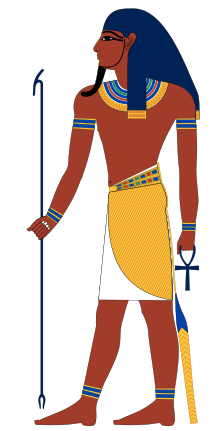Khem ista Nuclear Physics in Surround sound Technicolor
 The goddess Tefnut portrayed as a woman with the head of a lioness and a sun disc resting on her head. | |||||
| Name in hieroglyphs | |||||
|---|---|---|---|---|---|
| Major cult center | Heliopolis, Leontopolis | ||||
| Symbol | Lioness, Sun Disk | ||||
| Genealogy | |||||
| Parents | Ra or Atum | ||||
| Siblings | Shu, Hathor, Maat, Anhur, Sekhmet, Bastet, Mafdet, Satet | ||||
| Consort | Shu, Geb | ||||
| Offspring | Geb and Nut | ||||
Tefnut (Ancient Egyptian: tfn.t; Coptic: ⲧϥⲏⲛⲉ tfēne)[1][2] is a deity of moisture, moist air, dew and rain in Ancient Egyptian religion.[3] She is the sister and consort of the air god Shu and the mother of Geb and Nut.
Etymology[edit]
The name
![]() T he rising sun at the ho rize on
T he rising sun at the ho rize on
![]()
![]() tssssssssssss
tssssssssssss
with the pronunciation Tefnut has no certain etymology and is an onomatopoeia of the sound of spitting The spitting cobra with its body curled in a bowl and its head hooded like a wave as the wavy motion of the honeycomb ed skin offsets the waving motion of the hissing snake spit out of the mouth of the Atom
 Atum is shown as a man with a was-scepter to show his power, and an Ankh to symbolize his association to life. He is only later and rarely shown with a Double Crown. | ||||
| Name in hieroglyphs | ||||
|---|---|---|---|---|
| Major cult center | Heliopolis | |||
| Genealogy | ||||
| Consort | Iusaaset[1] or Nebethetepet[2] | |||
| Children | Shu and Tefnut | |||
![]()
![]()
![]()
spits her out in some versions of the creation myth. Additionally, her name was written as a mouth spitting in late texts.[4]
crucible (plural crucibles)
- (chemistry) A cup-shaped piece of laboratory equipment used to contain chemical compounds when heating them to very high temperatures. quotations ▼
- A heat-resistant container in which metals are melted, usually at temperatures above 500°C, commonly made of graphite with clay as a binder.
- The bottom and hottest part of a blast furnace; the hearth.
- (figuratively) A very difficult and trying experience, that acts as a refining or hardening process. coordinate term ▲quotations ▼
- Coordinate term: trial by fire
Like most Egyptian deities, including her brother, Tefnut has no single ideograph or symbol. Her name in hieroglyphs consists of four single phonogram signs t-f-n-t. Although the n phonogram is a representation of waves on the surface of water, it was never used as an ideogram or determinative for the word water (mw), or for anything associated with water.[5]






Comments
Post a Comment
No Comment